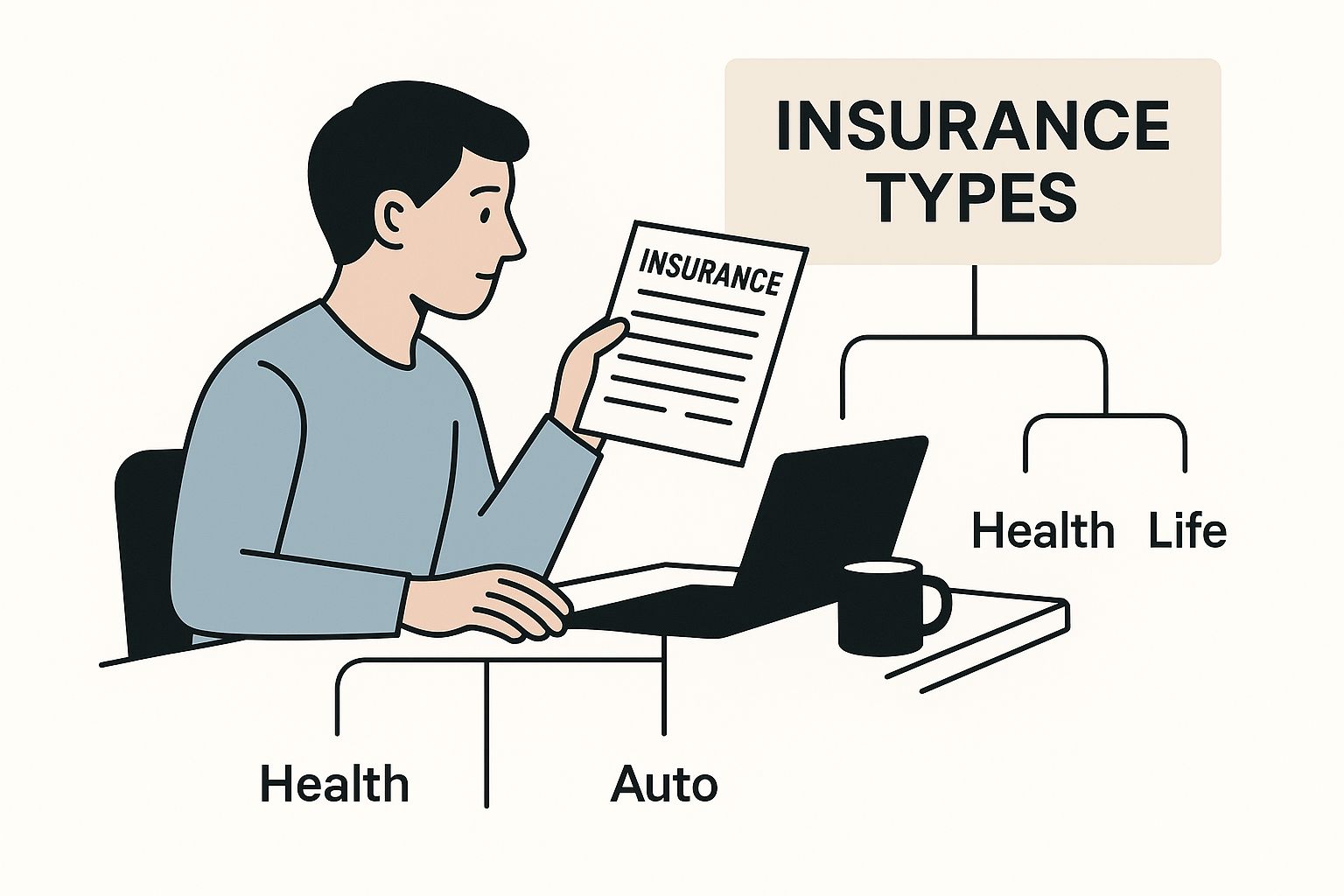
Decoding The Rehab Insurance Coverage Maze
Imagine you’ve just completed a much-needed rehab program, feeling hopeful about the future. Then, reality hits: a stack of medical bills lands on your doorstep. Suddenly, the relief is replaced by anxiety. Navigating rehab insurance coverage can feel like wandering through a maze, especially when you’re already dealing with the stress of recovery. This guide is here to help you find your way.
So, why do some rehab treatments get approved quickly, while others seem to get lost in the system? The magic word is medical necessity. Insurance companies have specific criteria for what they deem medically necessary. Think of it like this: if you’re building a house, you need a solid foundation. Similarly, a strong claim needs a solid foundation of medical necessity. For example, after a knee replacement, your doctor’s recommendation for intensive physical therapy needs to clearly link the therapy to restoring your mobility, not just general wellness.
This brings us to another critical piece of the puzzle: documentation. Just like a detective needs evidence to solve a case, you need documentation to support your claim. Detailed medical records, your doctor’s recommendations, and even personal statements explaining how the rehab impacts your daily life, all build a stronger case for your treatment. This is especially important if you need to appeal a denied claim. Knowing what the insurance company looks for helps you present your case effectively, increasing your chances of success.
The Growing Need For Rehab Services
The demand for rehab services isn’t just a personal story; it’s a global trend. According to a study in The Lancet, the global need for these services has increased by a staggering 63% since 1990, with the number of people benefiting from rehabilitation growing from 1.48 billion to 2.41 billion. This growing need highlights the importance of accessible and comprehensive insurance coverage for rehab.
This screenshot from the World Health Organization (WHO) website emphasizes their focus on rehabilitation services. It underscores the growing global recognition of rehab as a vital part of healthcare.
Timing Is Key
Finally, there’s the element of timing. Understanding the insurance company’s timelines for processing claims and appeals is like knowing the traffic patterns in a city. You can use this knowledge to your advantage. For instance, submitting all required documents at once, instead of in bits and pieces, can speed up the review process.
Knowing the ins and outs of rehab insurance coverage empowers you to get the care you need without facing unexpected financial burdens. It’s your roadmap to a smoother, more successful rehabilitation journey.
Call Now – Your Journey to Recovery Begins Today!

Take the first step towards a healthier life! Call now to connect with our compassionate team and start your recovery journey today. Your path to healing awaits!
Our recovery specialists are available 24/7 to provide support, and all calls are confidential and free. Reach out anytime – we’re here to help!
Understanding Your Coverage Options Like An Expert
Navigating rehab insurance coverage can feel overwhelming, a bit like searching for a needle in a haystack. Medicare, Medicaid, and private insurance each have their own quirks and understanding these differences can significantly impact your expenses. Just as you wouldn’t use a wrench to hammer in a nail, you need the right insurance “tool” for your specific rehabilitation needs. This boils down to understanding what each coverage type offers and how it applies to you.
The infographic below visually represents the landscape of insurance options you might encounter during your search for rehab coverage. The image depicts someone reviewing insurance documents, emphasizing the often-confusing process of navigating these choices. The “Insurance Types” text highlights the variety of plans available, encouraging us to consider which one aligns best with our individual situation.

As the infographic shows, selecting the appropriate insurance isn’t one-size-fits-all. Understanding the distinctions between Medicare, Medicaid, and private insurance is key to maximizing your benefits and minimizing costs. Medicare Part B, for instance, might be a good fit for outpatient therapy, while private insurance might offer stronger coverage for inpatient rehab. For more information on insurance coverage for rehab, check out this helpful guide: Addiction Helpline America’s guide on insurance coverage.
Medicare Vs. Private Insurance: A Real-World Example
Let’s illustrate the differences between Medicare and private insurance with a practical example. Consider a patient recovering from a stroke. Under Medicare Part B, they might receive coverage for 80% of outpatient services like physical, occupational, and speech therapy. This coverage is a key driver in the growth of the medical rehabilitation services market, especially in major markets like the United States. Learn more about the impact of insurance coverage on rehab services. However, Medicare coverage often comes with limitations on the number of visits or the overall duration of coverage.
In contrast, a private insurance plan could provide more extensive coverage for inpatient rehabilitation, potentially covering a greater portion of the expenses associated with a specialized rehab facility. The trade-off, though, might be pre-authorization requirements and stricter eligibility criteria. This underscores the importance of knowing the specifics of your individual plan.
To help visualize the differences between common insurance types, let’s take a look at this comparison table:
Comparison of Major Insurance Types for Rehabilitation Coverage
| Insurance Type | Inpatient Coverage | Outpatient Coverage | Coverage Percentage | Annual Limits |
|---|---|---|---|---|
| Medicare | Varies by Part (A, B, etc.) | Typically 80% under Part B (after deductible) | Dependent on specific services and plan | Subject to plan limits and annual deductible |
| Medicaid | Varies by state and individual circumstances | Generally comprehensive but may have limitations | Often low to no cost-sharing | Dependent on state regulations |
| Private Insurance | Varies widely by plan | Varies widely by plan | Wide range (e.g., 50% – 100%) after deductible and co-insurance | Varies widely by plan; may have separate in-network and out-of-network limits |
This table provides a general overview and specific coverage details will vary.
As you can see, coverage can differ quite drastically depending on the insurance type. It’s crucial to consult your plan documents for the specifics of your coverage.
Telerehabilitation And Evolving Coverage
The growing popularity of telerehabilitation adds another dimension to the coverage equation. While some insurers are readily covering these remote care options, others are still catching up. This is particularly relevant for people in rural communities or those with limited access to traditional rehab facilities. Knowing your plan’s stance on telerehabilitation can open up valuable treatment avenues.
Coordinating Multiple Policies For Maximum Benefit
Having multiple insurance policies can be beneficial, but it requires coordination. Understanding which policy is primary and which is secondary can help you avoid unexpected costs and get the most out of your coverage. This often involves communicating with both insurance companies to understand how their policies work together. Think of it like managing a team – each policy plays a specific part in your overall coverage strategy.
Cracking The Eligibility Code That Actually Works
Insurance companies don’t always spell it out, but eligibility for rehab coverage isn’t just about having a policy. It’s about understanding your insurer’s specific criteria and presenting your case effectively. Imagine applying for a loan: you need more than a bank account. You need good credit and a repayment plan. Similarly, securing rehab coverage involves demonstrating medical necessity and providing the right documentation.
Medical Necessity: The Cornerstone of Eligibility
Medical necessity is the foundation of rehab insurance coverage. It means the treatment is essential for your health, not an elective procedure or for general wellness. Clear communication with your doctor is key. Their recommendations should directly link the rehab to your diagnosis and explain how it will improve your specific condition.
For example, if you need physical therapy after a car accident, your doctor’s notes should explain how the therapy will restore lost function, not just improve overall fitness. It’s about demonstrating a specific medical need.

This screenshot from the Centers for Medicare & Medicaid Services (CMS) website shows the importance of understanding Medicare coverage. Just like any insurance, Medicare has specific requirements for different services, and knowing these details is crucial for determining eligibility.
Navigating Medicare, or any insurance coverage for that matter, can be tricky. Understanding the nuances of your specific plan is vital for successful claims and appeals.
Documentation: Building a Strong Case
Think of it like building a legal case: you need evidence. For rehab coverage, your evidence is strong documentation. This includes detailed medical records, diagnostic test results, and your doctor’s treatment plan.
Personal statements about how rehab will improve your daily life can also strengthen your claim. These documents tell the story of your recovery and why this treatment is necessary.
Timing and Appeals: Strategic Maneuvers
Timing matters. Know your insurer’s deadlines for pre-authorization and claims. Submitting everything on time and accurately can prevent delays.
If your claim is denied, don’t give up. Appeals often succeed when you understand the denial reason and provide additional information to address the insurer’s concerns. It’s like revising a paper: you use feedback to make your argument stronger.
Pre-Existing Conditions and Coverage Gaps: Navigating the Challenges
Pre-existing conditions and gaps in coverage can complicate things. However, knowing your policy’s exclusions and limitations can help you anticipate potential problems.
Working with a patient advocate or insurance broker can be a huge help. They understand the complexities of insurance and can advocate for you, guiding you through the process.
Filing Claims That Get Approved (Not Lost In Limbo)
Filing a rehab insurance claim can often feel like navigating a complex maze. The difference between a smooth, successful claim and one that disappears into the void often comes down to understanding the nuances of the process. Think of it like applying for a dream job: you wouldn’t send a generic resume and cover letter, would you? Instead, you’d carefully tailor your application, highlighting the skills and experiences that align with the specific job description. The same principle applies to rehab insurance claims – thoughtful preparation and a targeted approach are essential for success.
Timing: The Magic Window for Approvals
Insurance companies operate on specific timelines, and understanding these timelines can greatly increase your chances of a swift approval. Think of these timelines as “magic windows”—periods when claims are processed most efficiently. For instance, submitting your claim within a certain window after your initial assessment might significantly expedite the process. It’s like strategically using off-peak hours to avoid traffic – knowing the optimal timing can make all the difference.
Documentation: The Key to a Smooth Process
Imagine delivering a presentation – a well-organized, visually compelling presentation makes a stronger impact, right? The same holds true for your insurance claim. Presenting the right documentation in a clear, organized manner is crucial. Specific documentation like detailed medical records, a doctor’s recommendation clearly outlining the medical necessity of the rehab program, and even personal statements describing how rehab will positively impact your daily life can significantly strengthen your claim. This documentation acts like evidence in a court case, providing concrete support for your need for rehab.
Decoding Denials: Common Pitfalls and Solutions
Understanding the common reasons for claim denials is like having the answers to a test beforehand. Many denials stem from issues related to demonstrating medical necessity, providing insufficient documentation, or missing critical deadlines. By being aware of these potential pitfalls, you can craft stronger submissions from the outset. For example, if your claim is denied for lack of medical necessity, providing supplemental documentation from your doctor that explains the specific benefits of rehab for your particular condition can often lead to a successful appeal. It’s similar to responding to reviewer comments on an academic paper – providing more detail and clarification strengthens your argument.
When Claims Get Stuck: Insider Strategies
Even with the best preparation, sometimes claims get stuck in the system. This is when understanding the inner workings of the insurance process and having a few insider strategies can be invaluable. A simple phone call to the insurance company to check on the status of your claim can sometimes be enough to dislodge it from bureaucratic limbo. It’s like following up on a job application – proactive communication keeps your application top-of-mind. Working with a patient advocate can also be a game-changer. These professionals understand the complexities of the insurance landscape and can act as your guide, helping you navigate the process and advocate for your needs.
Call Now – Your Journey to Recovery Begins Today!

Take the first step towards a healthier life! Call now to connect with our compassionate team and start your recovery journey today. Your path to healing awaits!
Our recovery specialists are available 24/7 to provide support, and all calls are confidential and free. Reach out anytime – we’re here to help!
The Real Financial Picture Behind Rehab Coverage

Rehab is an important investment in your health, and like any significant investment, it’s essential to understand the costs involved. Thinking about insurance can feel overwhelming, but breaking it down can make it much clearer. It’s similar to planning a big home renovation project – you wouldn’t start knocking down walls without a detailed budget, right? Similarly, understanding your rehab insurance coverage is crucial for a smooth recovery journey.
Let’s unpack some key insurance terms. Your deductible is the amount you pay out-of-pocket before your insurance company starts contributing. Think of it as the initial threshold you need to cross. A copay is a fixed amount you pay for each service, like a doctor’s visit or therapy session. It’s like a small fee for accessing each service. Coinsurance is the percentage of the costs you share with your insurance company after you’ve met your deductible. It’s like splitting the bill with your insurer.
Breaking Down Real-World Cost Scenarios
Let’s illustrate this with an example. Imagine someone needs physical therapy after a car accident. If their insurance plan has a $500 deductible, they will pay the first $500 of their physical therapy bills. Let’s say their plan then covers 90% of the costs (meaning their coinsurance is 10%). They’ll be responsible for 10% of each therapy session until they hit their out-of-pocket maximum. This maximum is the most you’ll have to pay out-of-pocket during the year. Once you reach this limit, your insurance typically covers 100% of the eligible expenses.
To give you a better sense of potential expenses, let’s look at a table summarizing average costs and typical insurance coverage for some common rehabilitation services. Remember, these are averages and can vary significantly based on your location, specific provider, and insurance plan.
| Service Type | Average Cost | Typical Insurance Coverage | Patient Responsibility | Session Frequency |
|---|---|---|---|---|
| Physical Therapy | $75 – $150 per session | 70% – 90% | 10% – 30% | 1-3 times per week |
| Occupational Therapy | $100 – $200 per session | 70% – 90% | 10% – 30% | 1-3 times per week |
| Speech Therapy | $75 – $175 per session | 60% – 80% | 20% – 40% | 1-2 times per week |
| Inpatient Rehab (per day) | $1,000 – $3,000 | Varies widely, often requires pre-authorization | Varies significantly | Daily |
This table highlights the variability in costs and coverage, reinforcing the importance of checking your specific policy details. Knowing your plan’s specifics—deductible, copay, coinsurance, and out-of-pocket maximum—helps you plan effectively.
The need for these services is growing, too. The medical rehabilitation services market is projected to reach USD 492.4 billion by 2034, growing at a CAGR of 6.17% from an estimated USD 287.28 billion in 2025. This growth underscores the increasing demand for rehab services. Discover more insights into the medical rehabilitation services market.
Strategic Cost Management
What if your insurance coverage isn’t enough? There are ways to manage costs strategically. Many rehab facilities offer payment plans or adjust fees based on income (sliding scales). Don’t hesitate to explore these options – they can significantly ease the financial burden. You may also find helpful resources at California Addiction Treatment.
Timing Strategies and Out-of-Pocket Considerations
Timing your rehab can also impact your expenses. If your deductible resets at the beginning of the year, starting your rehab early in the year could potentially minimize your out-of-pocket costs. Sometimes, paying out-of-pocket might surprisingly be the more economical choice. For instance, if a short-term, intensive program costs less than your deductible, paying directly might save you money compared to using insurance. Each situation is unique, so carefully weigh your options.
Insider Strategies For Maximum Coverage Benefits
Getting the most out of your rehab insurance coverage isn’t simply about having a policy—it’s about understanding how to use it effectively. Think of it like having a toolbox full of shiny tools. Owning them doesn’t automatically fix anything; you need to know how to use them. Similarly, you need to know how to use your insurance policy to your advantage. Here are some insider strategies to help you do just that.
Coordinating Multiple Policies: A Synergistic Approach
Many people have more than one insurance policy, often through their own employer and their spouse’s. Coordinating these policies can significantly increase your overall coverage. It’s like having two buckets to fill a larger container – you’ll fill it much faster using both at the same time rather than one after the other. Figure out which policy is primary and which is secondary. This helps avoid claim denials and ensures you’re using both policies efficiently.
Out-of-Network Providers: When It Makes Sense
While in-network providers are generally cheaper upfront, sometimes going out-of-network can be more cost-effective in the long run, particularly if you need specialized treatment. Imagine needing a specific part for your car. The generic part might be cheaper, but if it breaks down quickly, you’ll end up spending more in the long run than if you’d bought the more durable, name-brand part initially. Similarly, if an out-of-network provider offers a therapy not available in-network, the long-term benefits might justify the higher initial cost.
Timing Treatments Strategically: Optimizing Coverage Periods
Just like planning a vacation around off-season rates can save you money, strategically timing your rehab treatments can optimize your coverage. Starting treatment early in the year, before your deductible resets, can minimize your out-of-pocket expenses, especially if you anticipate needing ongoing care. This is like using a coupon before it expires—you’re taking advantage of a limited-time opportunity to save.
Documentation: Turning Good Coverage Into Great Coverage
Thorough documentation is key to maximizing your benefits. Think of it like building a house: a solid foundation of detailed records is essential for a strong structure. Medical records, doctor’s recommendations, and even personal statements all support your claim. These documents provide a comprehensive picture of your need for rehab and how it impacts your daily life, significantly improving your chances of approval and maximizing your benefits.
Building Relationships: The Power of Communication
A positive relationship with your insurance representative can be incredibly helpful. Think of it like nurturing a garden: regular communication and attention help it flourish. Regularly checking in with your representative, asking questions, and addressing any concerns promptly can smooth the claims process. A strong relationship can be invaluable when navigating complex coverage situations.
Common Mistakes and Advocacy Strategies
Avoiding common errors, like forgetting pre-authorization or submitting incomplete paperwork, is crucial. It’s like following a recipe – missing a key ingredient can ruin the entire dish. Double-checking your claim before submitting prevents costly mistakes. And if you encounter coverage limitations or denials, advocating for yourself is important. Think of it like negotiating – clearly explaining your needs and providing supporting evidence can often lead to a successful resolution. These strategies can empower you to get the most out of your rehab insurance coverage.
Call Now – Your Journey to Recovery Begins Today!

Take the first step towards a healthier life! Call now to connect with our compassionate team and start your recovery journey today. Your path to healing awaits!
Our recovery specialists are available 24/7 to provide support, and all calls are confidential and free. Reach out anytime – we’re here to help!
Building Your Long-Term Coverage Strategy
Thinking about your future rehab insurance needs might feel like a distant concern, much like planning for retirement. But just as your financial needs evolve over time, so too might your healthcare requirements. A proactive approach to rehab insurance coverage is essential for navigating potential future health challenges. This means assessing your current coverage in light of possible future needs and understanding which policy features are most important.
Life Changes and Insurance Decisions
Life is full of unexpected turns. Changes in your career, the natural aging process, or the development of chronic conditions can significantly impact your rehabilitation needs. Imagine a job that involves a lot of physical labor – this might increase your risk of needing physical therapy later in life. Similarly, as we age, the need for occupational or speech therapy often becomes more common. These are the kinds of changes that should inform your insurance decisions before the need for care arises. Just as you’d change your clothing with the seasons, you should adapt your insurance coverage to life’s transitions.
Identifying Coverage Gaps and Maximizing Value
Finding potential gaps in your coverage before they become costly problems is a bit like regularly checking your car’s oil – it prevents major issues down the line. Ask yourself important questions: Does your current policy adequately cover long-term rehabilitation services, such as in-home care or assistive devices? Which policy features, like lower out-of-pocket maximums or a wider network of providers, will offer the best value over time? Understanding these details helps you choose a policy that truly fits your needs. Medicaid might also be a valuable resource for you: Check out our guide on Medicaid.
Emerging Trends and Staying Ahead of the Curve
The world of rehabilitation is always changing. Think about telerehabilitation, for example. It provides remote access to care, but insurance coverage for it varies widely. Staying informed about new trends and policy changes, such as new coverage options for innovative therapies or shifts in reimbursement rates, is similar to keeping your software up-to-date. It ensures you’re taking advantage of the latest features and benefits. Actively seeking out information and asking questions will help you stay on top of these developments.
Preparing for Future Needs
Creating a long-term coverage strategy means looking beyond your current needs and considering future possibilities. By evaluating your current policy, understanding your potential future needs, and keeping up with emerging trends, you can develop a plan that makes the most of your insurance investment. This proactive approach equips you to handle any rehabilitation needs that may arise, ensuring you have access to the care you need, when you need it. Think of it as having a well-stocked first-aid kit – you’re prepared for whatever life throws your way.
Ready to take charge of your recovery journey? Addiction Helpline America provides confidential support and guidance for individuals and families dealing with addiction. We offer resources and help you find suitable treatment options, including rehab facilities that work with your insurance coverage. Visit us at Addiction Helpline America to learn more and begin your path toward a healthier future.
Our helpline is 100%
free & confidential
If you or someone you care about is struggling with drug or alcohol addiction, we can help you explore your recovery options. Don’t face this challenge alone—seek support from us.
Programs
Resources
Will my insurance
cover addiction
treatment?
We're ready to help
Find the best
drug or alcohol treatment
center
Are you or a loved one struggling with addiction? Call today to speak to a treatment expert.















